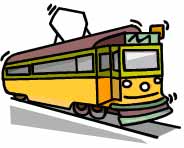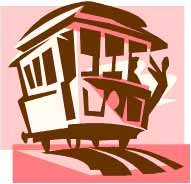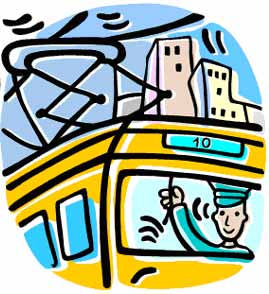Riding the Streetcars
by Amy Kenneley
"Stand Back!" someone said, as the streetcar pulled up to the safety zone--the raised, lozenge-shaped cement platform in the center of Euclid Ave. & E.105th St. Someone stepped backwards and I was nudged, teetering towards passing traffic. Mother, who had been holding my hand anyway, just yanked me back.
Although streetcar types changed both in style and technology through the years, the basic streetcar was made of metal and shaped like a long pill, rounded at each end. Windows ran the length of the car, with 3 large divided windows in the front and bow windows in the rear. A round single headlight was affixed to the front of the car, and a matching round brake light to the rear. The familiar "cow-catcher" attached to the front of the streetcar below the headlight was meant to keep obstacles clear of the wheels and rail, and could be a variety of styles-with a pointed prow, a flat, slanted grating or vertical bars.
Then everyone on the platform pressed themselves toward the open doors of the long buff-colored streetcar. Sometimes the off-people and on-people elbowed one another in their hurry to get where they were going, but today-in the first winter since World War II ended-- riders were in a happy and polite mood. We worked our way past the bi-fold doors and up the steps to where the motorman stood.
The Euclid Line was one of the longest streetcar routes in Cleveland. The line made return runs from Public Square to Windermere Station in East Cleveland. The separate and competing streetcar companies before and since 1900 had gradually been merging into what became in 1942 The Cleveland Transit System-CTS. In 1946, the year Cleveland celebrated the Sesquicentennial of its founding, the streetcar system had its peak ridership, with 493 Million rides.
Motorman and Conductor
 The motorman was yesterday's bus driver. He sat on a tall stool and in front of him were handles that made the streetcar stop and start. The motorman was yesterday's bus driver. He sat on a tall stool and in front of him were handles that made the streetcar stop and start. Above the front windshield was the sign mechanism telling where the streetcar was going. With black letters on a white background, it was made of a cloth-like material. About a yard wide, the rollers at top and bottom could be rolled back and forth with a small crank to show the car's destination. Our destination said Public Square.
The motorman nodded to his "regulars" as people climbed on, but mainly he was watching the traffic outside and glancing into his mirror to see what was happening behind him.
The conductor was the second in charge on the streetcar. He was collecting fares from everyone and issuing transfers as well. If you were going to transfer from one streetcar line to another, you also bought a transfer slip.
Once you had paid your first fare, the transfer slip cost only a few pennies. If you had to transfer a second time you were given a "free" transfer on the next streetcar The conductor made change from a money-changer he had clipped to his belt, and pulled a flimsy strip of colored paper a little larger than Monopoly money out of his uniform pocket- the transfer. It had the routes printed on it.
He used his paper punch to punch a hole in the correct route. You had to use the transfer that day-you couldn't keep it for tomorrow. If you weren't sure how to get to another place in town, the conductor knew. For less than half a dollar you could travel all around Cleveland.
The new streetcars had leather seating, with small handholds sculpted out of the metal frame for those passengers who had to stand. Some seats in the front faced into the aisle, and other seats towards the back faced forward, two to a side or two on one side and one on the other side. Spaced at intervals down the aisle were poles running from floor to ceiling. Standees could cling to the poles and still see out, because above the regular windows were narrow clerestory windows so those standing could watch for the street signs-and read the advertising cardboards placed between upper and lower windows, spanning the length of the aisles.
Manners
The seats were filling quickly. Several gentlemen got up from their seats and offered them to ladies. One man raised his hat a few inches off his head as he got up, and the other one took his hat brim between his thumb and forefinger, giving it a gentle tug. The ladies who took over the men's seats smiled graciously, nodding-- in a courteous but not familiar way-- to thank the gentlemen.
Prime Seating
Midway down the car we passed the black coal stove. It glowed cheerfully, and was the only heat in the long, cold trolley. Our breath was coming out in little clouds, like cartoon people speaking in the funny papers. The conductor got to stand near the stove when he wasn't busy. He threw in a little shovelful of coal as we squeezed by.

Working our way to the back, Mom still held tightly to my hand, dragging me in between the people standing in the crowded car. Because I was short, I got to inhale all the grown-up people's smells as we squeezed our way along. The wet, musky fur of collars and trims on coats, cigarette smoke clinging to woolens, then MMMMMM-someone was wearing Evening in Paris-besides Mom.
Hooray! The big back seat was empty. The last seat curved around like a built-in booth. I loved to sit there better than any other place. You could see everything as you went along with no one to block your view. Best of all, the roll and sway of the car seemed like a boat going through the water. Mother always looked a little anxious when we rode in the back. I guess she wasn't as seaworthy as I was.
On both sides of the streetcar above the windows was a bell cord dipping in shallow scallops as it passed through eyelets. When someone wanted the car to stop, they would pull the cord once, for stop. When everyone was off, the conductor pulled the cord twice, and the brass bell up by the motorman sounded its soprano note--DingDing!- letting the motorman know that all was clear and the doors could be closed.
Ready for the Ride
The crossroads of Euclid Ave. and E.105th St., known for years as Doan's Corners, was where we had boarded the streetcar. All around me was the familiar: Hoffman's (home of the most delicious hot fudge sundaes ever known) Keith's RKO Theatre, premier house of the five movie houses there. The sturdy stone of the Cleveland Trust Bank where Grandpa paid his house mortgage was on the opposite corner.
DingDing! The bell announced our departure. As the streetcar slowly picked up speed we passed Euclid-105th Market, and the Trianon Bowling Alley. Faster--Skateland, churches, more churches then the Cleveland Playhouse, The Health Museum. The wheels on the car hummed beneath my feet, and each time the car braked, a high pitched squeal vibrated the fillings in my teeth.
Cleveland streets were mainly dirt and mud in the late 1800's when the first streetcar tracks were laid. The horses pulling the cars needed a firm footing, so brickwork was laid between and near the tracks. By using the same type of wheels and track system used by locomotives, the cars also glided more easily.
With the coming of electricity, horsepower was replaced by more efficient methods. A power line about 18-20 feet off the ground and directly over the tracks was the power source. Midway on the roof of each streetcar, a boom-like pole rose at a backward angle up to the power line. A small reel at the end of the pole kept the pole snug against the power line so power could be conducted back into the streetcar.
More people were getting on at the next stop, and fewer people getting off. The car was filling up with downtown shoppers. From the corner of my eye I saw some movement behind the streetcar, and then the lights in the car went off and the undercurrent of motion and machinery ceased.
"Hey, you kids!!" shouted the conductor loudly, and he pushed against the lifeless car doors to get out. Running fast as lightning and laughing all the way, two boys were disappearing around the corner of the Western Auto store just as the conductor got to the back of the streetcar. The mischievous boys had found the Achilles heel of the streetcar and used it to have fun.
In order to disconnect power to the streetcar when it was being serviced or repaired, a length of rope was attached to the power boom a little below the connector reel. The rope dangled behind the boom and ran down into a coiling cylinder attached just under the rear window. To reconnect the power supply, the conductor would pull more rope out of the coiling cylinder in order to swing the boom pole back into position. By maneuvering the rope, he could swing the boom into place against the wire, restoring power.
The conductor realized that trying to catch them was futile, so with some muttering he began the corralling of the pole and the reconnection process.
I had a front row seat to watch him-- even if it was the back row. Cars passed on either side of the stranded Euclid car. With the wind and the snow as competition, the near-misses of the conductor were something to watch. Such sparking and zzzzz-ting when he came close to the power line but the boom bounced off! Sidewalk spectators came to a halt to watch, if only briefly, as they plodded towards their destinations.
A final zzzzz-ting and the lights flickered back on and the streetcar hummed beneath my feet. A murmur of satisfaction rippled through the people, with a few congratulatory comments to the conductor as he climbed back aboard. He pulled the cord to signal "Go" to the motorman-DingDing!--and off we went again.
The Endless City
We passed rows of apartment houses, office buildings, taverns, funeral parlors, shoe stores, beauty parlors, print shops, ice cream parlors, grocery stores.
Mother always pointed out the stop where the Dunham Tavern still stood "--going 'way back to the Indians" and the huge Masonic Temple. We passed Fenn College of Engineering, where my uncle had received his engineering degree.
We rolled into downtown, stopping at Playhouse Square, where all the big movie houses were located-the Palace, Loew's Ohio, Loew's State, and the Hippodrome. We stopped again at the Alpine Village, Chin's Pagoda Restaurant and then the Colonial Arcade. The big buildings rose like mountains. Pretty soon I could only see the tops of them by pressing my nose flat against the window and squinting upwards.
"Oh, look! There's the Terminal Tower!" Cleveland's icon was barely visible through the blowing snow, but I knew it was the tallest building in Cleveland. For some strange reason, that was the one place Mother never wanted to take me. Guess I was a Real Clevelander!
Before my breath had a chance to mist the glass, I could almost see the sky.
It seemed to me that I would never, ever have to go to another city for anything, for everything I could ever want was right outside my window.
The Square
At the Square, we scurried off and reached the safety of the sidewalk under the protection of the white-gloved policeman beckoning us as he stopped traffic. DingDing! The trolley pulled away and swung around the Square for a return trip back up Euclid Ave.
In front of us was our shopping goal, the glistening white bricks of The May Company. Next to the May Company's revolving doors was Morrow's Nut House, with enticing fragrances of roasting nuts scenting the cold air, beckoning pedestrians. After a morning of shopping, I knew our last purchase would be a half pound of Spanish peanuts before heading for home.
Scattered around the Public Square were narrow roofed waiting areas for passengers. Because of the unusual slant of the rooftops and the overlapping, rounded tiles, everyone called them pagodas. They were removed in 1955 to give the Square a more "modern" look.
Heading Home
Hours later, standing inside the shelter of a pagoda, Mother and I kept dipping into the white bag holding our warm Spanish peanuts, waiting for our return trip home. As the streetcar slid to a stop with much screeching and sparking of wheels, we wearily climbed aboard. I didn't care if we sat in the back, now. We fell into a two-seater, nestling our packages around us. DingDing! and the streetcar pulled slowly away, swaying gently back and forth. Soon, with my forehead resting on the cold window and my breath misting maps of strange continents on the glass, I was fast asleep.

In 1952, the "Parade of Progress" featured a long line of streetcars traveling down Euclid Avenue for the last time. Trackless trolleys and diesel-powered busses had taken over the job of moving Clevelanders from here to there. After the Parade, the tracks were torn up, the safety zone platforms jack-hammered out, and the street paved smoothly over with asphalt to welcome a new era.
The last streetcar line to operate was the Madison Ave, from Spring Garden Ave. in Lakewood to Public Square. It made its last run in January, 1954. Ten thousand Clevelanders stood in line for hours for a free ride, a ride that signaled the end of 94 years of streetcars in Cleveland.
(Two dings of the streetcar bell to James R. Spangler and James A. Toman, co-authors of Cleveland And Its Streetcars, 2005, Cleveland Landmarks Press, Inc., for historical and technical background for this article. An apology, also, to those streetcar buffs who may find errors in descriptions and data-the fault is mine.)
Top of Page
Back to Amy Kenneley Columns
|